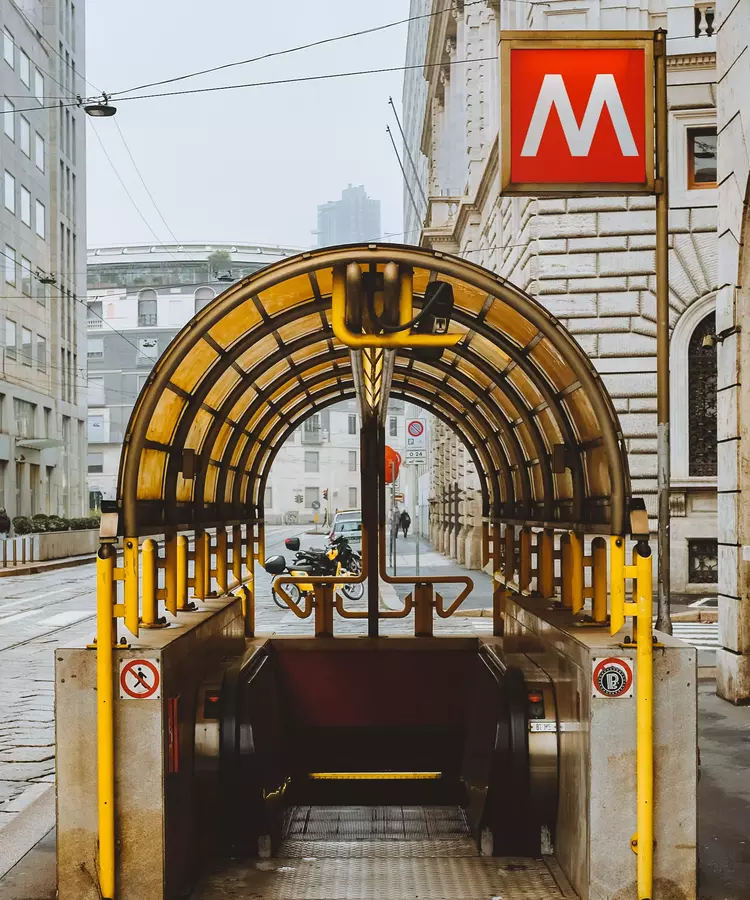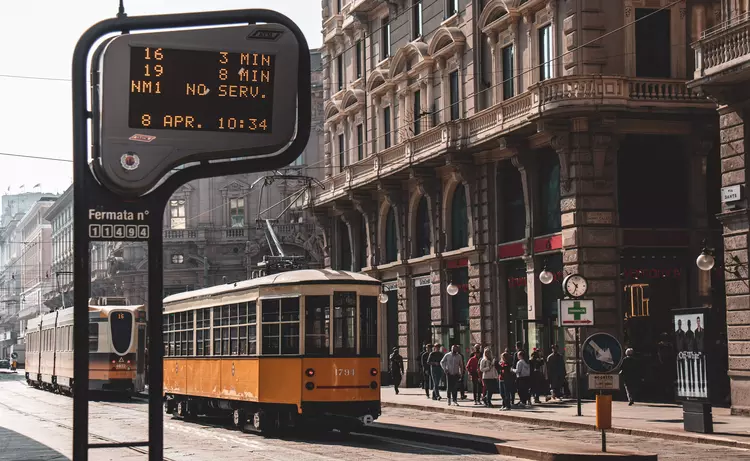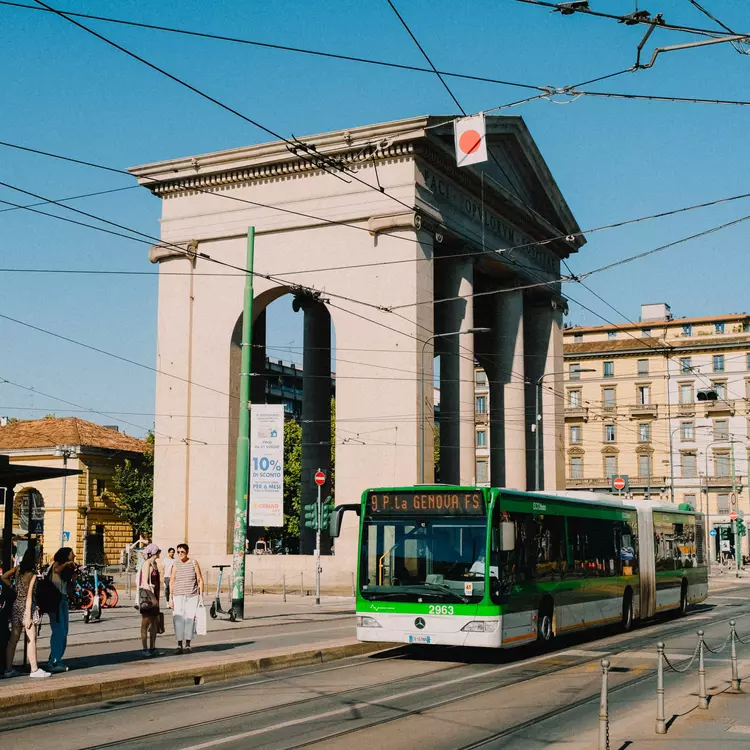Milan is the economic hub of Italy and has an efficient public transport system. The public transport in Milan is extensive, making it easy for travelers to enjoy different parts of the city without worry. Although initially, it might seem confusing to navigate using various modes of transport, it is certainly not too difficult, also this guide has you covered.
Milan has a long history when it comes to transportation networks. The city is home to an intricate network of canals called the Navigli, originally built in the Middle Ages as a means of transportation and irrigation. The famous Naviglio Grande is one such canal.
Today, public transport in Milan is managed by the ATM (Azienda Transporti Milanesi ) in an integrated manner spanning metros, buses, and trams. This means the same ticket or travel pass can be used for all modes of public transport and does not have to be bought separately. The public transport offered by ATM in Milan is the best and most inexpensive way to get around the city. Here’s everything you need to know about the different types of public transport in Milan
Metro
The Milan subway system consists of 5 operating lines, M1 (Red), M2 (Green), M3 (Yellow), M4 (Blue), and M5 (Lilac). The initial version of the metro began operation in 1964 and the latest was the addition of the M4 line at the end of 2022. The metro lines run for a total of more than 100 km and comprise 119 stations, making it the longest and most extensive network in Italy. All the metro lines run underground except for parts of the green or M2 line.
- M1 (red line) - First established and covers the highest number of stations. It runs between terminals Sesto Maggio and Biscieglie/Rho Fiera. Among the many stations, the red line has stops at the Duomo and the Lampugnano bus station.
- M2 (green line) - It runs between terminals Cologno Nord/Gessate and Assago Forum/Abbiategrasso. The green line is the longest and stops at the Milan Central Station (Milano Centrale).
- M3 (yellow line) - It runs between terminals Comasina and San Donato, allowing for easy access to the bus station at San Donato. The yellow line also has stops at the Duomo and Milan Central Station (Milano Centrale).
- M4 (blue line) - The newest addition to the Milan metro system, it is only partially open and runs between terminals San Babila and Linate Aeroporto (as of July 2023).
- M5 (lilac/purple line) - It runs between terminals Bignami and San Siro Stadio. The purple line stops at the Giuseppe Meazza/San Siro Stadium and can be found bustling on matchdays.

The Milan Underground has 7 stations, each with 2 lines creating an interchange point. These are, Centrale (M2 and M3), Duomo (M1 and M3), Loreto (M1 and M2), Cadorna (M1 and M2), Zara (M3 and M5), Garibaldi (M2 and M5), and Lotto (M1 and M5).
A single ticket costs 2.20€ and can be used for 90 minutes from the time of validation. Read this guide to know about the various ticket and travel passes in Milan, and which one you should buy. Milan metro tickets can be bought in shops (Biglietteria or Tabacchi), from the machines in the metro stations, online through the ATM app, or via contactless bank payments at the select orange turnstiles in metro stations.
The Milan metro operates between 05:30 AM to 12:30 AM. The frequency of the metro is between 2 to 4 minutes and has lower wait times during peak hours. On Sundays and holidays, the metro service starts later and ends sooner, with longer wait times of up to 7 minutes. Given all this, Milan’s metro is the fastest way to get around the city and is used by millions daily.
Tram
The electric trams in Milan have been running since 1893. Going further back, trams were at first horse-drawn. The Milan public transport has 19 tram lines on a network of around 180 km. The trams are numbered from 1 to 33. Most of the trams run through the city center around Duomo and some provide connectivity to the outskirts of the city. However, trams are not as frequent as the metro.
 ATM has a good combination of both historic and modern trams in its fleet. The Series 1500 tramcars were built in the late 1920s and offer a sense of history to its users. Some of these trams can also be found in other parts of the world like USA and Australia, mostly in museums. ATM also rents these historic trams to interested users.
ATM has a good combination of both historic and modern trams in its fleet. The Series 1500 tramcars were built in the late 1920s and offer a sense of history to its users. Some of these trams can also be found in other parts of the world like USA and Australia, mostly in museums. ATM also rents these historic trams to interested users.
Tickets for the trams in Milan, like the other modes of public transport, can be bought in shops (Biglietteria or Tabacchi), from the machines in the metro stations, and online through the ATM app. Since Milan has an integrated public transport system, the same ticket holds good even for traveling on the metro. Prices for a single ticket costs 2.20€, valid for 90 minutes, and there are more alternatives available depending on the duration of travel. Check out the article on tickets and travel cards for public transport in Milan .
Trams are a very convenient mode of transport and some of them give you a historic experience dating back close to 100 years. When traveling in the tram, ensure to signal where you intend to get down. This is done by pressing the “Request Stop” button, before your intended stop, present in various parts of the tram.
Bus
The Milan public transport system consists of 134 buses and 4 trolleybuses covering around 1500 km. Buses provide good connectivity throughout the city and are sometimes preferred when there is no metro or tram availability. The frequency and wait times of buses are similar to trams. Although buses take a slightly longer commute time compared to trams.
 The buses in Milan operate between 05:30 AM to 01:45 AM around midnight. If you find yourself looking for public transport past midnight, then the night buses have you covered. The night service by the ATM has 4 lines that operate all night. 90/91 trolley bus line, M1, M2, and M3 replacement lines. The night buses in Milan cover most of the city’s popular nightlife areas and take a route similar to the metro lines. Additional night bus lines are operating between Fridays and Sundays, details of which can be found on ATM’s official website
.
The buses in Milan operate between 05:30 AM to 01:45 AM around midnight. If you find yourself looking for public transport past midnight, then the night buses have you covered. The night service by the ATM has 4 lines that operate all night. 90/91 trolley bus line, M1, M2, and M3 replacement lines. The night buses in Milan cover most of the city’s popular nightlife areas and take a route similar to the metro lines. Additional night bus lines are operating between Fridays and Sundays, details of which can be found on ATM’s official website
.
Tickets for the buses in Milan can be bought, similar to the metro and tram, in shops (Biglietteria or Tabacchi), from the machines in the metro stations, and online through the ATM app. Note that the single tickets bought (and validated) after midnight are valid for use till 6 AM, unlike the usual 90 minutes. If the tickets are bought after 04:30 AM, they are valid for 90 minutes.
Not all bus stops have the traditional stand with the seat and waiting area, some bus stops are denoted by an orange-colored metal pole, indicating the stops and bus numbers operating in that route. Similar to trams, before your intended stop, make sure to notify by pressing the “Request Stop” button.
Bike
If you want to explore Milan at your own pace by taking your time, then the bicycle is a great option. BikeMi is Milan’s bike-sharing service that is available in most parts of the city. It is devised keeping the user’s mobility in mind and as a means to reduce congestion. Milan has several dedicated pathways for bicycles which makes it easy for its users.
To avail BikeMi’s services you need to have a subscription, either annual, weekly, or daily, that can be purchased either online or through the BikeMi app. The service is available between 06:00 AM to 12:00 AM on all days. There are different variants of bikes, for instance with and without a child seat, and the prices vary for each of them. To know more about the service and the various subscription plans check check out BikeMi’s official page .
Mode of Payment for Tickets
Tickets for the metro, tram, and buses in Milan can be bought through the ATM app, machines at the metro stations, or through shops like newspaper stands, bars, and tobacconists. Travel cards, on the other hand, are electronic cards that can be bought at select ATM points and authorized shops. When buying tickets using the machines at the metro stations, you can pay either by cash or credit card. If you are buying tickets at the designated shops, they usually only accept cash payments. If the ATM app is used for purchasing tickets then a credit card can be used for payment.
ATM has also introduced a contactless payment
system enabled through NFC which is only available on ATM transport services.
Validate your tickets
Do not forget to validate or stamp your tickets after you have purchased them. The ticket is considered valid only after it gets stamped. The machines for validating tickets are usually found in metro stations. The bus and tram ticket validation can be done using machines onboard buses and trams, usually attached to poles. Insert the ticket into the slot and it returns the stamped ticket to you. Although no one checks for your ticket when using buses and trams, random checks are performed when traveling. If anyone is found traveling without validated tickets, they will be fined.
Conclusion
The Milan public transport system is good and one of the best in Italy if not Europe. The metro, trams, and buses operate late, and they also have night buses from midnight until the early hours of the morning. The prices are not exorbitant and offer good value for money.
If you are in Milan for a short visit and staying in the vicinity of Milan’s center you might not need to use public transport. Milan is a walkable city with many attractions located in the city center but you might need to use public transport on occasion depending on where you stay and to explore other parts of the city.
Take a look at the official ATM Milano app
since it offers easier navigation, convenience to buy tickets, and checking the status of metro lines. The public transport in Milan is also disability friendly.
Are you planning to visit other parts of Italy by train from Milan, then check out the Milan train stations guide
for all that you need to know.